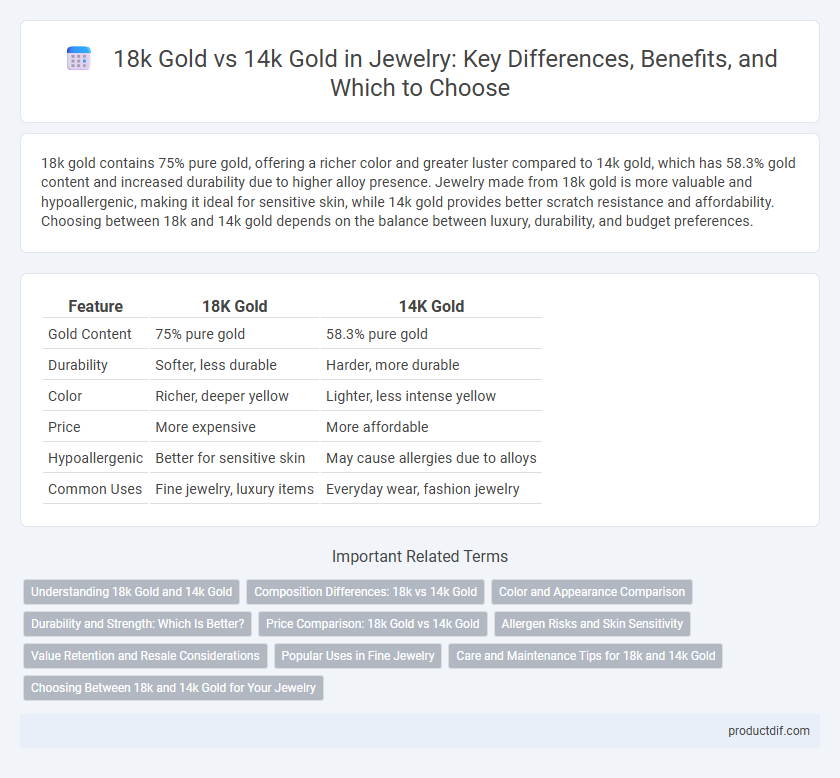18k gold contains 75% pure gold, offering a richer color and greater luster compared to 14k gold, which has 58.3% gold content and increased durability due to higher alloy presence. Jewelry made from 18k gold is more valuable and hypoallergenic, making it ideal for sensitive skin, while 14k gold provides better scratch resistance and affordability. Choosing between 18k and 14k gold depends on the balance between luxury, durability, and budget preferences.
Table of Comparison
| Feature | 18K Gold | 14K Gold |
|---|---|---|
| Gold Content | 75% pure gold | 58.3% pure gold |
| Durability | Softer, less durable | Harder, more durable |
| Color | Richer, deeper yellow | Lighter, less intense yellow |
| Price | More expensive | More affordable |
| Hypoallergenic | Better for sensitive skin | May cause allergies due to alloys |
| Common Uses | Fine jewelry, luxury items | Everyday wear, fashion jewelry |
Understanding 18k Gold and 14k Gold
18k gold consists of 75% pure gold alloyed with 25% other metals, offering richer color and higher purity compared to 14k gold, which contains 58.3% pure gold and 41.7% alloy metals for increased durability. The higher gold content in 18k gold makes it more valuable and prone to scratches, while 14k gold provides greater scratch resistance and affordability, suiting everyday wear. Both types balance gold purity and durability differently, catering to distinct preferences in jewelry craftsmanship and longevity.
Composition Differences: 18k vs 14k Gold
18k gold consists of 75% pure gold mixed with 25% other metals such as copper and silver, resulting in a richer gold color and higher purity compared to 14k gold. In contrast, 14k gold contains 58.3% pure gold combined with 41.7% alloy metals, which increases durability but reduces the richness of the gold hue. The higher gold content in 18k gold makes it softer and more prone to scratches, while 14k gold's stronger alloy composition improves its resistance to daily wear and tear.
Color and Appearance Comparison
18k gold exhibits a richer, deeper yellow hue due to its higher pure gold content of 75%, providing a more vibrant and luxurious appearance. In contrast, 14k gold contains 58.3% pure gold, resulting in a paler, lighter shade that is often preferred for a subtle, contemporary look. The increased alloy presence in 14k gold can make its color less intense, while 18k gold's higher gold purity enhances its warm, classic appeal.
Durability and Strength: Which Is Better?
18k gold contains 75% pure gold mixed with 25% alloy metals, resulting in a softer and less durable composition compared to 14k gold, which comprises 58.3% pure gold and 41.7% alloy metals. The higher alloy content in 14k gold enhances its strength and resistance to scratches and bending, making it more suitable for everyday wear and active lifestyles. For durability and long-term resilience, 14k gold outperforms 18k gold in maintaining structural integrity and surface hardness.
Price Comparison: 18k Gold vs 14k Gold
18k gold typically costs 20-30% more than 14k gold due to its higher purity and gold content, containing 75% pure gold compared to 58.3% in 14k gold. The increased gold percentage in 18k gold enhances its value and price, making it a premium choice for fine jewelry investors. However, 14k gold offers a more affordable option with greater durability, appealing to buyers seeking budget-friendly and long-lasting pieces.
Allergen Risks and Skin Sensitivity
18k gold contains a higher percentage of pure gold (75%) compared to 14k gold (58.3%), resulting in fewer alloy metals that often cause allergic reactions, making it a better option for sensitive skin. The increased presence of nickel and other alloy metals in 14k gold raises the risk of skin irritation and allergic contact dermatitis for individuals prone to metal allergies. Choosing 18k gold reduces the likelihood of allergen exposure while maintaining durability and aesthetic appeal in fine jewelry.
Value Retention and Resale Considerations
18k gold contains 75% pure gold, offering higher intrinsic value and better value retention compared to 14k gold, which has 58.3% gold content mixed with additional metals for durability. When considering resale, 18k gold jewelry typically commands a higher price due to its increased gold purity and luxury appeal, whereas 14k gold, though more durable and affordable, may have lower resale value. Market trends and demand fluctuations influence both 18k and 14k gold resale prices, but 18k gold generally maintains stronger value appreciation over time.
Popular Uses in Fine Jewelry
18k gold is preferred in fine jewelry for luxurious pieces like engagement rings, wedding bands, and high-end necklaces due to its rich color and higher gold content. 14k gold is widely used in everyday jewelry such as bracelets, earrings, and casual rings because of its increased durability and affordability. Both karats maintain a balance of beauty and strength, but 18k gold is favored for premium, elegant designs while 14k suits more wearable, everyday items.
Care and Maintenance Tips for 18k and 14k Gold
18k gold, composed of 75% pure gold and 25% alloy, requires gentle cleaning with mild soap and a soft cloth to preserve its richer color and softness, avoiding abrasive materials that may cause scratches. 14k gold, containing 58.3% pure gold mixed with harder alloys, is more durable and better suited for everyday wear but still benefits from regular polishing and storage in a soft pouch to prevent tarnish. Both 18k and 14k gold jewelry should be kept away from harsh chemicals, including chlorine and household cleaners, to maintain their luster and structural integrity over time.
Choosing Between 18k and 14k Gold for Your Jewelry
Choosing between 18k and 14k gold for your jewelry depends on your preference for purity and durability. 18k gold, composed of 75% pure gold, offers richer color and higher value but is softer and more prone to scratches. 14k gold contains 58.3% pure gold, making it more durable and affordable, ideal for everyday jewelry that withstands daily wear.
18k gold vs 14k gold Infographic

 productdif.com
productdif.com